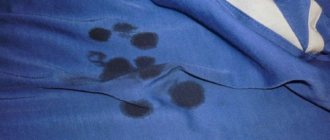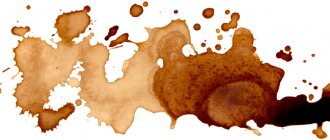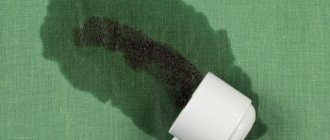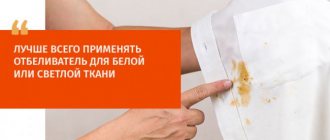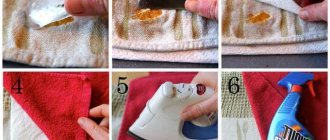Superglue is a strong adhesive that is popular due to its ability to glue objects made of different materials together. If handled carelessly, it can get onto the surface of the fabric and leave stains that cannot be removed during normal washing or using household products. Don’t rush to throw away your favorite denim trousers or jacket that are stained with superglue. You can restore the original appearance and remove the stain using substances, which we will talk about in more detail.
How to remove superglue using chemicals
There are several chemical products that can help remove superglue stains completely.
Dimexide for removing glue from fabric
This drug is sold in pharmacies and is used as an anti-inflammatory agent. It is necessary to soak the stain with Dimexide and leave the item for a couple of hours, and then remove the dirt with a cotton pad soaked in the preparation. But this method does not always help. In the case of an old, long-dried stain, other means must be used.
How to remove superglue from clothes with acetone
Acetone-based solvents and even nail polish remover are great for removing old glue stains.
It is necessary to soak two cotton pads in acetone, and then apply tightly to the stain on both sides and leave for 15 minutes. All that remains is to wipe the stain with a clean disc and wash the item in the powder solution.
Before using acetone, you need to check the reaction of the fabric on an inconspicuous area of the item. Delicate fabrics cannot be cleaned this way.
White spirit in the fight against dried glue stains
White spirit has a more gentle effect on fabric fibers. This solvent is widely used in everyday life.
The principle of operation is the same as in the case of removing stains with acetone: the dirt is dissolved using a cotton pad soaked in the product and wiped off with force.
How to clean car plastic
Remains of adhesive are removed from plastic parts of the car with dimexide. Work with rubber gloves. It is necessary to prepare in advance cotton swabs, rags made of coarse fabric, wooden or plastic scrapers.
Dimexide is applied to the area and thoroughly rubbed into it for 2-3 minutes. After softening, the mark is removed with a cotton swab, scraper or dry rag. If the stain is thick, remove it layer by layer, alternating rubbing with dimexide and scraping several times. After cleaning, the car plastic is moistened with water and wiped dry with a rag.
Since dimexide is aggressive, all work is carried out very quickly. Any delay may lead to the destruction of parts.
Home remedies to remove superglue
If the fabric is capricious, and the product is expensive, in order not to spoil it, it is better to try to scrub the fabric using delicate home remedies.
Rubbing alcohol to remove glue stains
Although ethanol is not as effective at dissolving glue stains, it can still be used to gently scrub off superglue.
You need to soak a cotton swab in pure alcohol and rub the stain with force from the edges to the center. When the cotton wool becomes dirty, it should be changed. There is no need to soak the fabric, as the alcohol evaporates very quickly.
How to remove glue stains with table vinegar
Table vinegar can be used to clean thin, capricious fabrics and even colored ones. It is necessary to soak the soiled clothes for a quarter of an hour in a solution of 250 ml of vinegar and 1 liter of warm water.
All that remains is to scrape off the glue with a blunt object and remove the remaining residue with tweezers. Vinegar should not be used on synthetic fabrics.
Removing stains with table salt
Salt helps remove stains so well that it can even handle superglue.
It is necessary to soak the product in a strong saline solution, for the preparation of which 2 tbsp. l. The product is dissolved in 500 ml of warm water. The item is soaked for a couple of hours. After this time, the glue can be easily removed with a blunt object.
Baking soda to remove glue stains
Just as in the case of salt, the item must be soaked in a strong soda solution. To prepare the solution, dissolve 50 g of soda in 500 ml of warm water. You can also apply a paste of baking soda and water to the stain and leave for a couple of hours. Soda must be constantly moistened.
Finally, the glue is collected with a blunt object and the residue is removed with tweezers.
Removing superglue with soap and boiling
Superglue is sensitive to high temperatures, so boiling clothes in a soapy solution will help to quickly remove it.
Requires 5 tbsp. l. Dissolve shavings of simple laundry soap in 2 liters of water and boil the item for half an hour. All that remains is to scrape off the glue with a blunt object and wash the thing. This method is only suitable if the material can withstand prolonged boiling.
Removing superglue stains with citric acid
If the stain has not yet become old and very dry, citric acid will help remove it.
It is necessary to dissolve 2 tbsp in 300 ml of water. l. lemon acid and moisten the affected area with this solution or soak it in the solution. After an hour and a half, you can wash the product as usual.
Freezing superglue stains
Superglue is afraid of low temperatures, so you need to put the item in a bag and put it in the freezer for several hours. Once frozen, the stain can be easily scraped off with a blunt object.
There are several reliable ways to remove even dried glue from fabric. But still, you shouldn’t wait until the stain gets old, because old stains are more difficult to remove.
Dimethyl sulfoxide can completely dissolve any glue. But it is impossible to purchase it in retail; the only option is to buy the so-called “Dimexide” solution, which is dimethyl sulfoxide in diluted form. The substance looks like a transparent colorless liquid. The substance has a specific odor reminiscent of garlic. Will dimexide help against glue, and under what conditions, we will analyze in this article.
Cleaning methods depending on the type of glue
- Cyanoacrylates (Superglue, Secunda, Cosmofen). The products have a similar composition and operating principle and do not contain solvents. Cyanoacrylates harden due to the reaction of water and air in the bonded surfaces. When hardened, cyanoacrylate resembles plastic. It can be removed with acetone, dimexide, anti-glue, soapy water. To avoid damaging the plastic, it is better to use anti-glue or soap solution.
- Medical BF-6. Contains synthetic resin, rosin. It dissolves in alcohol, but the composition does not react to oils, kerosene, gasoline and acids.
- Moment. A group of substances with various additives, resins, acetone, ethyl acetate, rosin. They dissolve well with dimexide and acetone.
- PVA (water soluble). The fresh glue is removed with water, and the dried glue is lightly rubbed, its edge is lifted with a fingernail or blade and the entire film is carefully removed. Can be removed with any solvents, including acetic acid.
- Titanium. It can be dissolved by gasoline, dimexide or concentrated plumbing acid. To prevent damage to the plastic, traces are cleaned off as quickly as possible.
How to remove glue using Dimexide?
Attention! Remember! The substance penetrates very easily into the blood under the skin, therefore, any work with it should be carried out only with gloves. Do not work with bare hands.
Dimexide dissolves superglue perfectly. For this process, you can use various methods of influence:
Which method to choose depends on various factors, the main one being the type of surface.
Be sure to familiarize yourself with the effect the solution has on various materials.
In addition to superglue, the product can easily remove polyurethane foam.
How to remove superglue using Dimexide
The difficulty of removing superglue depends on whether it is on a flat surface or whether it has flowed into a crack. Naturally, if the glue is in the crack, it is much more difficult to remove it.
If the second option, then you should soak the hole with glue in dimexide and wait. Once every day or two, the top layer should be removed and the rest left to soak. This will speed up the process. The main thing is that it is a place that the solution will not spoil.
The product can be used for any other glue using the same method as when removing superglue. If you use dimexide against other types of glue, soaking is unlikely to be necessary. Dimexide from Moment, PVA, silicate, carpentry glue will help you.
How to wash glue for tips?
Despite the fact that acetone is harmful to nail plates, without it it is quite difficult to properly remove tips and glue at home. So, apply a drop of acetone or nail polish remover under the pad, wait a little, then pry the artificial plate with an orange stick and carefully remove it.
Interesting materials:
How to root hydrangea in water? How to root chrysanthemums from a store bouquet? How to root juniper from cuttings? How can a Ukrainian travel to China? How can a Ukrainian come to Russia? How to decorate a room without renovation? How to decorate an empty wall in the living room? How to decorate an empty wall in the hallway? How to strengthen your immunity? How to strengthen joints and ligaments?
Step by step cleaning
So we have already learned that there are 2 ways to deal with dimexide with superglue.
This method can be used to wash rough materials that will not be harmed by the product: rough fabric, uncoated wood, car body, suspended ceiling.
If you are working with delicate materials that the product can damage, then use the same procedure, but do not soak. You will need the hard side of the sponge soaked in the solution and use it to scrub the surface. These include: soft fabric, plastic items, coated wood, leather, lacquered surfaces, laminate, furniture, shoes (shoes, sneakers, boots).
When using dimexide on combined objects, such as a car, remember that by using it on a surface where the solution cannot damage anything, you can catch the material that will deteriorate from interaction with it. Again, using the example of a car, the plastic rims of the headlights or the radiator grill may be damaged.
What surfaces can be cleaned from glue with dimexide?
Dimexide against superglue helps on various surfaces, but you need to take into account that it affects both the glue and the surface. For this reason, different approaches should be applied to different materials.
Plastic
When removing glue from plastic, you should never soak it, only wipe the stain with a cotton swab, otherwise you risk damaging the surface. If you take dimexide, removing the glue will be easy. But it’s better not to even try to use a solvent.
Tree
To remove the glue layer we use dimexide, but then we will have to sand it. If the wood is coated, the product cannot be used.
Textile
It all depends on the type of fabric; dimexide can be used to remove glue from coarse fabrics. But if you have thin, delicate fabrics, it’s better not to even touch dimexide to them, otherwise your clothes will be completely ruined.
Glass
In principle, you can use dimexide to remove superglue from glass, but keep in mind that this only applies to ordinary glass. If your optics are stained with superglue, then you can damage them irrevocably with dimexide, so it’s better to choose a different option.
Rubber
For rubber it is better not to use it at all; it may happen that it becomes saturated with dimexide and becomes brittle.
Dimexide for superglue is a very effective remedy, but when working with it, the main thing is to remember safety precautions; under no circumstances ignore gloves. Be sure to consider the type of surface on which superglue is applied. If you take into account all the nuances, then you will need a minimum of effort to achieve the desired result, and at the same time you will not damage anything with this solution. This is a super tool in the fight against these kinds of problems.
Temperature method for cleaning superglue
The temperature method will help remove a fresh stain from jeans. It is only effective if the cyanoacrylate has not yet completely hardened in the fabric fibers.
How to carry out the cleaning procedure:
- take the iron and heat it to maximum temperature;
- iron the stain on the jeans on one side and the other. In this case, it is necessary to iron through a sheet of paper, for example, newspaper, or gauze, folded in 2-3 layers.
After a few minutes, you will see how the superglue particles begin to break down and roll off. Brush them off the fabric. Repeat the process until the adhesive is completely removed from the surface.
How to remove superglue: the best methods for various surfaces
Good afternoon, dear readers! Whoever invented superglue deserves at least a Nobel Prize. It’s hard to imagine how many things glue saved from going to the trash, how much money it saved their owners. But its strength is not always a good thing. When an accidentally spilled composition gets onto surrounding objects and surfaces, it turns out that it is very difficult to remove it without leaving a trace.
To save the situation, you need to know how to wipe off superglue, how not to spoil the object from which it is being removed and how not to harm your health.
How does superglue work?
The substance that forms a strong connection on the glued parts is cyanoacrylate. The glue penetrates cracks and pores, filling them, and interacts with moisture particles contained in the air, tightly holding the surfaces together.
Trying to wash the glue off with water will cause it to harden even more.
The connection is not only durable, but also resistant to moisture, temperature changes and mechanical damage. Removal of contamination should begin as early as possible to prevent complete drying.
Cyanoacrylate is also interesting because it practically does not react with other substances, even solvents. Therefore, choosing an effective method can be quite difficult.
How to remove superglue
There are four main groups of methods by which you can remove the adhesive composition. The greatest effect can be achieved if a set of measures is applied.
Mechanical techniques
This category includes manipulations that use force: scraping, rubbing, knocking, grinding.
The main disadvantage of such measures is the high probability of damaging the base and rendering the item unusable. If they are used to remove film from your skin, there is a risk of injury. Therefore, you need to be careful and try not to overdo it.
Impact of temperature
Although cyanoacrylate is able to withstand temperature changes, systematic increased exposure to heat or frost gradually destroys its structure. This can be used to remove stains using an iron, hair dryer or freezer. Typically these techniques are used to clean fabric.
Professional products
Manufacturers took care of consumers and developed a special product called “Anti-glue”. It quickly and effectively dissolves contaminants, but it cannot be applied to some materials: varnished and painted, as well as certain types of plastic.
Due to its high toxicity, children's clothes should not be treated with such a mixture. For the same reason, direct contact with skin should be avoided and gloves should be used.
Instructions are included with each product and must be strictly followed. Otherwise, there is a risk that the composition will not work or will damage the surface.
Chemical compositions
This includes any type of solvent: acetone and liquids containing it, “White spirit”, “Thinner 646”, “Dimexide”, gasoline, alcohol.
All these substances destroy cyanoacrylate, making the contamination easily removed. However, it is worth considering that they themselves are very aggressive, and therefore can harm the object being processed and ruin its appearance.
It is better to work with solvents in the fresh air or in well-ventilated areas, and also wear gloves and a mask!
Traditional methods
They come to the rescue if nothing more effective is at hand. They act more slowly, but are safe and will not cause harm to health. Here is a list of popular folk recipes.
Rules for removing glue from various surfaces
When working with superglue, drops can get on the parts being glued, the table, the floor, clothes and hands. And in each specific case the methodology will be different. But there are some general recommendations:
This is perhaps the most common problem. All it takes is one careless movement - and there will already be a sticky mark on your fingers and palms, to which something can instantly stick. Or the fingers will completely stick together.
There are many methods for removing adhesive film from skin. Let's name five of the most effective and safe ones.
Before using any of these techniques, it is advisable to soak your hands in hot, soapy water for 5 minutes.
Be sure to lubricate your hands with a nourishing cream after the procedure to prevent the development of irritation and help the skin recover.
In addition, it is permissible to treat the skin with a solvent, “Dimexide” or “Anti-glue”, but all of them are harmful to health, and therefore it would be wise not to rush with them and use them only as a last resort.
In general, you don’t have to do anything at all: in a couple of days the scales will fall off on their own. To speed up this process, simply wash your hands and use a scrub more often.
Textile
Another common problem is the composition getting on clothes or furniture upholstery. The method of eliminating trouble here often depends on the type of material: the thinner the material, the more delicate the handling must be. Be sure to first try any of the described recipes on an inconspicuous area of the item.
At the end of the treatment, do not forget to wash your clothes with washing powder.
Leather and suede
For such products, cleaning with Anti-Glue is recommended. You should treat the stain with the product, wait the prescribed time and carefully peel off the adhesive layer. Afterwards, wipe the surface with soapy water.
For suede you will have to use a whole range of measures:
You should not subject leather items to the procedure with an iron or hair dryer: they will be hopelessly damaged.
Tree
Wooden surfaces may vary. In some cases, it is necessary to save the untreated base; in others, drops of the composition fall on painted or varnished furniture.
Glass and tiles
These materials are smooth and pore-free. The adhesion of the adhesive deposit is not so strong, and therefore it is easier to remove it than with other bases.
Any chemical agent can be used. Cover the surface with a dampened cloth and leave for 20 minutes. Then all that remains is to pick up the film and remove it.
You shouldn't use beating here. There is always a risk that the glass will break and the tiles will crack. Sometimes it is justified to use a sharp knife or razor: you need to carefully scrape off the frozen layer from the glass. However, be extremely careful to avoid scratches.
Finally, you will have to wash the glass and tiles and wipe them to remove streaks.
If “Moment” accidentally gets on the screen of your phone or tablet, you can remove it with “Dimexide”. Use a cotton pad soaked in the substance to wipe the screen until the stain disappears. Afterwards, be sure to wipe the equipment with a damp cloth.
Plastic and silicone
Contamination from glue on the phone cover or case made of plastic and silicone is removed using the same “Dimexide”, “Anti-glue”, nail polish remover (without acetone) or vegetable oil. The first three products are used in the same way as when working with glass: wipe with a cotton swab.
Rub the oil on the plastic and leave for a couple of hours. Then you need to rub the stain with the same disk. It would be good to bend the silicone object in different directions so that the glue peels off. Finally, rinse the cover.
In addition to the methods described above, you can also remove dirt from plastic furniture with White Spirit or gasoline. There are also good reviews about the use of false eyelash remover.
Some types of plastic are sensitive to chemicals and will warp or melt when in contact with them. For such items, treatment with a soap solution is suitable. Place a soaked rag on the stain and wait at least three hours, periodically wetting the rag to prevent it from drying out. During this time, the glue softens and will be easy to clean.
Metal
Residues of the composition can be removed from the metal using a solvent, false eyelash remover, “Dimexide” or hydrogen peroxide. Using a sponge soaked in the selected cleaner, treat the metal until the problem disappears.
You can clean the surface with a metal dishwashing sponge. True, this technique is only suitable for bases that are not afraid of scratches.
Separately, it is worth mentioning the removal of marks from the car body. Although it is made of metal, the paintwork is very sensitive to all kinds of chemicals, and even more so to mechanical stress. Therefore, it is better not to take risks and fix the problem with Anti-Glue.
Glue should be removed from the floor covering, taking into account some features:
At the end, do not forget to rinse off the cleaner and wipe the floor dry.
See how Dimexide works on laminate:
Super glue
Superglue, along with many great inventions, was born by accident, but, as befits a substance with such a name, it has firmly established itself in a variety of economic sectors. In this article we will tell you what superglue is and what it comes in, what it can and cannot do, and we will also share useful tips and tricks for using such glue.
“Superglue” is the Russian translation of the trademark “Super Glue”. In the USSR, superglue was produced under the name “Tsiakrin”, and today you can find on sale the brands “Super-moment”, “Secunda”, “Monolith”, “Elephant”, “Pattex”, “Sila”, “Cyanopan”, “Glue” - which are essentially the same product.
What is superglue
The composition of the substance that we used to call “superglue” necessarily includes 97–99% cyanoacrylates, that is, cyanoacrylic acid esters, plasticizers, stabilizers, and in case of insufficient moisture in the joint - activators, as well as retarders.
To obtain an adhesive gel, ultrafine silicon oxide is also added to the composition for thickening. Solvents are not included in superglue.
The mechanism of action of superglue is actually simple - under the influence of slightly alkaline agents (ordinary water is one of these substances, and atmospheric humidity is quite sufficient), the substance polymerizes, i.e. hardens, becomes hard, while reliably fastening both surfaces together.
Conventional adhesives based on cyanoacrylates can easily withstand a load of 150 kg/cm2, and more advanced ones, for example, BlackMax from Loctite - 250 kg/cm2. The heat resistance of regular superglue is up to 70–80 degrees, modified - up to 125 degrees.
Classification of superglue
In our country, it is customary to call any glue that contains cyanoacrylates and hardens almost instantly “superglue.” However, in fact, there are several varieties of this substance:
One-component superglue based on ethyl cyanoacrylate. As the name implies, it does not contain additional active substances. It perfectly glues a variety of surfaces and hardens quickly - for this useful property it is called second glue. The full hardening period does not exceed 24 hours at air humidity of at least 55%, but in general, after just a minute the surfaces are held securely, and after two hours the glued object can be used without fear.
Two-component. An adhesive that contains not only a cyanoacrylate binder, but also fillers that give it thermal and electrical conductive properties. The remaining characteristics of the two-component adhesive are similar to the one-component composition.
Depending on their consistency, superglues are divided into:
1. Liquid, they are thin or penetrating. They are used only where the gap is very small - they penetrate perfectly between two tightly fitting parts, into holes less than 0.05 millimeters thick. 2. Average. Universal adhesives that have the widest range of applications. 3. Viscous or gel-like. Capable of filling small voids.
The history of superglue
Like a lot of other ingenious inventions, superglue was discovered completely by accident, not once, but twice. The American chemist Harry Coover was not at all busy searching for the ideal adhesive; in 1942, the development of plastic for optical sights was much more urgent.
Coover used cyanoacrylates in his work, but quickly abandoned his idea, since these substances tightly adhered to any surface and laboratory equipment quickly failed.
Unfortunately, at that time, Harry Coover did not appreciate all the prospects of the accidentally discovered properties of cyanoacrylates and continued to work on improving optical sights with other materials.
It was only in 1951, 9 years after the first discovery, that the chemist, working with his colleague Fred Joyner to create an acrylic polymer for jet canopies, again encountered the amazing properties of cyanoacrylates and this time decided to take the creation of superglue seriously.
It took the scientist another seven years to develop the optimal composition of the substance, adding stabilizers and plasticizers, and finally, in 1958, EastmanCompound 910 was ready for use.
By the way, the Russian name “superglue”, which we usually call all adhesives based on cyanoacrylates, is tracing paper with SuperGlue - under this name Dr. Harry Coover patented his composition. It's a pity, but superglue began to make a profit only after the SuperGlue patent expired. However, Harry Coover deservedly received his share of fame, he himself starred in advertising for his invention and was awarded the US National Medal of Technology and Innovation.
Scope of application of superglue
Superglue is widely used in a variety of fields of activity - in everyday life, industry, production, instrument and mechanical engineering, repair and construction. For the most part, “superglue” is used for gluing non-porous or water-containing materials. First of all, cyanoacrylate adhesives are used where quick gluing is required: for rubber seals in window production, for attaching mounted radio elements, parts of components in instrument making, optical parts, microcircuits, racks, washers, mounting harnesses and individual conductors to the bases of boards, as well as for securing other elements of radio equipment. In everyday life, the amateur method of using superglue and baking soda as an epoxy composition for filling seams, cracks, and chips is often used. The mixture hardens instantly and resembles acrylic-like plastic. The seam is successively filled with baking soda, moistened with superglue and in this case playing the role of not only a filler, but also an alkaline polymerizing agent. In some cases, the mixture can successfully replace epoxy compositions, including those reinforced with fiberglass mesh, however, safety precautions should be taken due to the toxicity of the resulting mixture. You can also use finely ground plaster or concrete as a filler, for example, dust obtained when drilling holes in such materials.
Currently, the number of modifications of superglue is constantly growing, and accordingly, the scope of its use is expanding.
Thus, in medicine, superglue is already used as a sealant to stop bleeding and treat wounds. And not so long ago, Swedish scientists developed a superglue composition that will help treat fractures, including the spine and skull bones, without the use of metal plates.
Modern superglues can withstand enormous loads, so they can be used not only for gluing small parts, but also perform much larger tasks.
Thus, the new Loctite superglue is considered the strongest in the world and was included in the Guinness Book of Records. As evidence, two cars weighing over five tons together were glued with Loctite to a metal frame and raised to a considerable height. The cars lasted for some time, and the representatives of the Book of Records used only nine drops of superglue to glue them together!
According to scientists, over time, superglue will be able to replace welding and other, more labor-intensive types of connections.
As we can see, today superglue is truly universal and is used literally everywhere where dissimilar or small materials need to be glued together efficiently and as quickly as possible.
Pros and cons of cyanoacrylate superglue
Superglue is a very strong and reliable adhesive substance that has a number of advantages:
- • high curing speed – at room temperature and within a few seconds; • high reliability of the connection – often the adhesive seam is stronger than the material being joined; • the ability to connect materials of different structures; • single-component, ensuring ease of use; • no need for special treatment of the surfaces to be joined; • resistance to temperature and humidity; • the ability to connect inclined, vertical, porous and absorbent surfaces; • vibration resistance and peel strength; • aesthetic, invisible adhesive seams.
Some of the disadvantages of superglue include:
- • limitation of the possibilities of use with large gaps; • temperature restrictions – no more than 80-100 degrees Celsius; • rigidity of the connecting seam, i.e. inapplicability for connections experiencing fracture loads; • inapplicability for joining polypropylene, polyethylene, Teflon and silicones.
Super glue:
- - does not dissolve in water, ethanol, dichloroethane and many other substances, but on the contrary, instantly hardens in places of contact with them. - softens from dimethyl sulfoxide, and also dissolves under the influence of heptane, acetone and isopropanol.
Shelf life. Cyanoacrylate adhesives are stored in sealed packaging in closed, ventilated areas, in places protected from moisture and direct sunlight. The guaranteed shelf life under these conditions at room temperature is 6 months, at a temperature not exceeding +5 °C - 12 months.
Constant contact with water or a damp environment leads to a gradual decrease in the strength of adhesive joints.
Instructions for use
First of all, superglue is suitable for hard materials with a smooth surface. It is less suitable for soft, absorbent and elastic materials (for example, for repairing leather clothing).
Moderately porous materials (eg wood) can be reliably bonded with longer setting times (30 seconds to 2 minutes). Glue is not suitable for highly absorbent materials. It is conditionally suitable for glass, since the adhesive joint dries out over time.
Since superglue sets within a few seconds, it is preferable to use for gluing small surfaces.
The thinner the adhesive layer, the more reliable the connection and the faster the glue sets, so it is not suitable for filling cracks and voids.
The glue is absolutely transparent and gives an almost invisible connection. Withstands SHORT-TERM exposure to water. Glued products can also be exposed to temperatures over a wide range: withstands any temperature up to +80 ° C (low temperatures - almost without restrictions).
The prerequisite for successful gluing is a perfectly clean and dry surface. If the material allows this, it is recommended to repeatedly wipe the gluing area with solvents (acetone, etc.). When gluing metals, simply clean the surface with sandpaper or a brush.
It is necessary to apply instant glue to one of the surfaces to be glued and immediately connect it to the second. Excess glue can be removed with a paper towel immediately after use.
Bonding of parts (depending on the material) occurs in a few seconds or a few minutes. Maximum bond strength is achieved after 12 hours.
The gluing area can be quickly dried with a hot hairdryer or sprinkled with baking soda. High humidity speeds up the gluing process, so you can blow on the applied adhesive to speed up the gluing process.
To remove Chinese superglue from fingers and various surfaces we use: - alcohol, - baking soda and warm water, which we wash with a sponge, - acetone or nail polish remover with acetone, - dimexide is sold in a pharmacy, it also removes foam from any surface . We wet the dried glue, wait 20 minutes, then wash it with a sponge, cloth or cotton pad soaked in dimexyl. After removing the glue, we wipe the surface with soapy water - a special liquid for washing off superglue - remove superglue from clothes and fabrics with a hot iron, several times ironing the fabric on the back side or through gauze on the outside, the glue cracks and crumbles under this influence. You can moisten the glue on the fabric with acetone and iron it with a hot iron.
The adhesive joint can be separated by heating up to 180°C and prolonged exposure to certain solvents.
Safety precautions when working with superglue
Since superglue hardens and glues surfaces instantly, and also has a number of other features, the following safety rules should be observed when working with this substance:
1. Even if you are as careful as possible, a drop of glue may still end up on your clothing, so be sure to protect your clothing. 2. Cyanoacrylate vapors are toxic - be sure to work with glue in a ventilated area. 3. Use the required amount of glue. You should not apply a lot of superglue for the following reasons: firstly, it will increase its hardening time and worsen the quality of work; and secondly, there is a high probability that the excess will protrude from the seam and fingers or other objects that were used to press the glued parts will stick very firmly to the part. 4. Since the glue sets instantly upon contact with atmospheric humidity, the tube spout often becomes clogged. Therefore, before reuse, it should be carefully cleaned with a needle or the tip of scissors. Under no circumstances should you press on the tube in the hope of punching it with force - the glue can shoot out a considerable distance, and in the best case, you will stain your clothes or table, in the worst case, the glue can get into your eyes. 5. The tube of glue should be directed away from you, preferably downwards, trying to cover it as much as possible with your hand, thereby eliminating the possibility of superglue getting into your face, especially your eyes - if the glue gets on the eye shell, it causes a serious burn, which requires long-term treatment and medical intervention! If glue splashes get into your mouth or eyes, they must be kept open and rinsed under running water for 15 minutes, after which be sure to consult a doctor. 6. You should not bend or fold a started tube of superglue. It breaks very easily at the bends - you will stain your hands, clothes, or ruin the part being glued.
And another serious danger is that when gluing materials that contain cellulose, such as cotton fabric and paper, there is a possibility of an exothermic reaction, that is, sudden heating and even ignition. That is why safety regulations prohibit the use of woolen and cotton clothes, especially cotton gloves, when working with glue that contains cyanoacrylates. Otherwise, you may get a burn, minor if there is not enough superglue, but serious if the amount is large enough.
Today, special types of superglue have already appeared, which, thanks to special additives, can be used for gluing cardboard and do not cause an exothermic reaction.
Poisonous properties of cyanoacrylates
Let us immediately note that in the hardened state, superglue is safe, so it can be used for gluing a cup or plate. BUT! You still shouldn’t drink hot tea from such a cup, because superglue softens when exposed to liquids at temperatures above 70 degrees. So we recommend using cyanoacrylate glue only for gluing decorative tableware, such as a painted plate or flower vase, and not for serving items from which you plan to eat.
In liquid form, directly during gluing, superglue releases toxic fumes, which in high concentrations can cause nausea and dizziness.
Therefore, we repeat, you should work with superglue in rooms with good ventilation.
However, there are special types of cyanoacrylates, for example, octyl-2-cyanoacrylate, which is the least toxic of all cyanoacrylates. Such adhesives are considered medical and were successfully used during the Vietnam War to stop bleeding, provide first aid to victims and glue wounds.
Today, the LifePath patch, developed with superglue, is applied to wounds when the surgeon cannot pinpoint the source of bleeding and firmly seals the damaged area, saving the patient's life.
So, not long ago, medical superglue saved the life of a three-month-old girl with a brain aneurysm. Specialists at the University of Kansas Clinic sealed the site of a rupture in the child’s artery with medical superglue, which literally “soldered” the site of hemorrhage into the brain in a few seconds.
Storage methods
It is likely that only a small amount of super glue will be used. This is because when it is opened, it quickly becomes unusable and the glue quickly hardens on the spout of the tube, which prevents the glue from coming out. To reduce this problem, always wipe the tube spout clean and store it upright to prevent glue from clogging the inside of the spout.
During storage, superglue dries quickly. In order for it to serve for a long time, it is not enough to close it with the “original” plug. After use, the bottle of glue should be placed in any suitable sized jar with a screw-on lid. Then it is stored for a long time. In this sealed form, it can be placed in the refrigerator for long-term storage. Additionally, you can add a handful of rice or silica gel to the jar to absorb water vapor. Rice absorbs water well from the air.
Another way to economically use and carefully store a tube of superglue: Unscrew the tip, pierce the foil on the tube, carefully tilting and perhaps barely squeezing the tube with your fingers, apply a drop to the needle, immediately turn the tube vertically so that the glue does not leak out anymore (and it flows new almost like water, even if you don’t put pressure on the tube), apply glue with a needle to the surfaces to be glued, glue it together, wipe the tube (with paper, preferably thin) from the glue near the puncture, and screw on the closed plastic spout, putting a couple of layers of cellophane on the neck of the tube (isolates the glue from air and is easy to tear off). As a result, the glue will not dry out in the tube and, with due care, can be reused as many times as necessary until it is completely used up.
A significant amount of superglue from the bottle can be poured into a syringe and closed with a needle bent with pliers for a tight seal. It also keeps for a long time.
How to carefully remove superglue from a plastic surface
Method 1
If the glue has not dried yet. You need to take a rag soaked in warm soapy water and quickly remove any spilled glue. Wipe the area with a degreaser (you can use nail polish remover).
Method 2
A gentle way. Suitable for delicate plastic surfaces. If you find an old, dried superglue stain that is ruining your desk, it will take much longer to clean it up.
You will need:
- A soft cloth;
- soap solution.
Soak a rag in the soapy water and, without squeezing, cover the superglue stain with it. With prolonged interaction with water, the glue softens and can be removed from the surface. It takes two to three hours for Moment glue to become soft, sometimes more. The amount of time depends on the amount of glue and how much it has dried. If during this time the rag dries out, it must be periodically moistened or covered with film.
This method can remove stains from plastic tables, glossy and painted surfaces.
Method 3
This method is universal and will help remove stains from any glue, including “moment” glue.
You will need:
- cotton pad or sponge;
- kerosene or gasoline.
Moisten a cotton pad or sponge with solvent and wipe the stain. This action should be repeated until the surface of the plastic is clean. It is important to note whether the plastic surface changes color during such cleaning. It will be unsightly if your table has a light spot that has to be hidden. If the plastic becomes lighter, you should stop the procedure and use method 2.
Method 4
You will need:
- rag;
- universal glass cleaner.
This method will help remove a stain of not completely dried superglue. The area of contamination should be moistened generously and wiped with a dry cloth. If you were unable to clean it the first time, you should repeat the procedure until the plastic is completely clean.
Method 5
Another gentle method that will help remove a stain of dried glue.
You will need:
- rag;
- Dimexide – concentrate (99%).
Dimexide can be bought at any pharmacy. It is not as aggressive a solvent as, for example, acetone. In order to remove glue from plastic using this method, you should moisten a rag with the concentrate and wipe the stain. Do not leave a rag soaked in dimexide on a plastic surface. With prolonged exposure, the plastic may become deformed and succumb to dissolution. When working with Dimexide, care must be taken. It may cause skin irritation, so it is best to use rubber gloves.
Method 6
You will need:
- rag or cotton pad;
- ethanol
Ethanol can be purchased at a pharmacy. It won't dissolve super glue, but it will help soften it. A rag or cotton pad is moistened with alcohol and left on the stain. After this procedure, the glue is easier to remove mechanically. If the stain is not on the front surface of the product, but still catches your eye (for example, on the leg of a garden plastic table), then you should try to remove the softened glue with a knife or razor.
Method 7
Many superglue manufacturers have heard about the problem of removing their product from surfaces. They produce Anti-Glue product specifically for this purpose. You need to know exactly the brand and type of glue whose stain is bothering you.
When working with Anti-glue, you must follow the instructions. Usually it is simple: apply a layer of Anti-Glue to the dried glue for a couple of hours. After this, the glue can be easily removed from the surface by rolling.
Method 8
Thermal. If you are confident in the quality of the plastic, it is heat-resistant (for example, it is a heat-resistant plastic surface of a table or window sill), then you should try this method.
You will need:
- container (teapot, ladle, mug) with a flat bottom;
- hot water.
Hot water is poured into a container or heated directly in it. It must be placed on the spot of glue “moment” and wait. Only heat-resistant glue can withstand high temperatures. After heating, removing the glue from the plastic is not difficult.
When working with superglue, you should be very careful. Removing it from any surface is a very labor-intensive process. If you drop or spill it on a plastic table, you need to be prepared for a number of difficulties.
The difficulty in removing superglue from plastic surfaces is that there is a chance of staining or damage. To clean plastic, you should use strong solvents such as acetone or white spirit; they can chemically damage the plastic or leave discolored spots on it. If this is the only option, try first on an invisible part of the product.
Useful tips
In this section we will answer the most popular questions that arise when using superglue.
Gluing small parts:
Does superglue conduct current? Regular one-component superglue is not, it is an insulator. There are special adhesives that, with the help of special fillers, obtain the ability to conduct current or heat.
Yes Easy!
WD-40 is great for removing superglue. Spray, wait a minute and separate from skin and hair.
Other different ways:
1. Wet the area stained with superglue with warm water and soap thoroughly. The soap solution needs to be foamed properly. And, preferably, rub with a pumice stone or a stiff brush. This step should already improve the situation by 50 percent. 2. Then put some salt on the super glue. 3. Add a little more water to the salt. 4. Now rub the salt into the problem area for one minute. 5. A white paste should form. 6. Wash your hands and there will be no trace of glue left.
Superglue often sticks fingers together, since working in rubber or latex gloves is not very convenient when it comes to small parts, and cotton gloves, as we remember, cannot be used. A special anti-glue solvent will help you cope with the problem; you can also simply wash your hands with hot water and soap and rub with a washcloth, use acetone or Dimexide pharmaceutical solution.
If your fingers are stuck together, thoroughly moisten the glued fingers with acetone and wait. Acetone softens cyanoacrylate, but not instantly, do not try to immediately separate your fingers, especially by force, be patient! Do not let the acetone evaporate completely; it is advisable to apply a cloth well soaked in acetone to the gluing area; you do not have to wet your fingers every minute. In particularly difficult cases, sometimes you have to wait about 40-50 minutes - it depends on the glue and the area of the glued fingers.
When using Dimexide, you should carefully read the instructions, since the drug is toxic and is intended for external use only. And don’t worry, even without using solvents, superglue will come off your fingers by itself in a couple of days.
How to remove superglue from clothes? If a drop of superglue gets on your favorite jeans or sweater, you should use an Anti-Glue solvent again. However, not all fabrics can boast the necessary resistance to this chemical, so try applying a little solvent to an inconspicuous area, and then clean the stain. Another option is to heat the glue stain with an iron through a thin fabric, alternately on one side and the other. Under the influence of high temperatures, the glue is destroyed and your clothes will become clean after intense heating with the iron. As long as the glue stains are not too dry, they can be removed from clothing with purified gasoline. Another option is to soak the fabric for a couple of hours in a soapy solution (2-3 tablespoons of washing powder + 1 tablespoon of ammonia), after which the problem areas should be scrubbed with an old toothbrush. And if the glue has frozen in drops on the surface of the fabric, it is better to fold the clothes into a plastic bag and put them in the freezer. After a few hours, try gently scraping off the frozen drops with a sharp knife, but remember: this method is not suitable for fabrics that require special care.
How to clean superglue from a table? If the surface of the table is covered with polish, then only the spot of the stain should be left open, and the rest should be covered with cellophane so as not to damage the polish. You can use pharmaceutical dimexide or solvent 647. Attempts to remove superglue from the surface of the table by heating with a soldering iron or iron are fraught with fire, and it is also unknown how the polish, varnish or paint itself will react to heating - together with the glue stain, the table may lose part of the surface itself . The simplest and most effective way is to use a kettle or ladle with boiling water - such a vessel should be placed on the glue stain for a while. Not a single ordinary superglue can withstand temperatures of 100 degrees, only modernized ones.
Baking soda + superglue
For working with superglue in thick layers, an amateur method is known with sequential filling of the seam with superglue and baking soda, which in this case plays the role of not only a filler, but also an alkaline polymerizing agent. The mixture hardens almost instantly, turning into an acrylic-like filled plastic, and in some cases can successfully replace epoxy compositions, including those reinforced with fiberglass mesh. The correct gluing sequence is: first moisten the surface with superglue, then cover it with soda, then moisten the soda with superglue again. In this case, the gluing will be as strong as possible.
The reaction of superglue with soda occurs with the release of temperature, as a result of which, when applied to plastics and porous materials, a very strong connection is obtained with the formation of molecular bonds. Moreover, the connection is so strong that most likely, the second time, the thing will break in a different place, but the superglue will hold up. Instead of soda, in some cases you can use cotton wool from cotton pads, graphite, salt and other available materials.
Baking soda + superglue release toxic gases, so work with caution in a well-ventilated area or outdoors. You can install a fan to prevent glue vapors from getting into the lungs, throat and eyes. In some cases, it is useful to use safety glasses to protect your eyes from exposure to adhesive fumes.
Finally, I would like to talk about several curious cases of using superglue, which, although they look, to put it mildly, ridiculous, still prove the reliability and amazing adhesive properties of this substance.
Thus, one resident of Germany, having ended up in a Spanish prison, decided not to part with his fiancee, who came to see him on a date, and asked her in advance to bring superglue for gluing car parts. The couple poured superglue onto their palms and exchanged a firm handshake. As a result, it took doctors several days to separate the lovers.
And the Mexican schoolboy did not want to go to school so much that he simply glued his hand to the headboard and still missed one day of school, during which his parents and doctors tried to unhook him.
The worst thing happened to an Englishman who became a victim of pranksters who smeared superglue on a toilet seat in one of the public toilets in London. The poor guy had to go to the hospital straight from the steel seat.
Cyanoacrylate vapor is used to detect fingerprints on objects. You can play Sherlock without leaving home: just take the cap of a plastic bottle or jar and drop a few drops of superglue on the inside surface. Now hold this “device” against glass, a mirror, or, for example, a door handle for a few seconds. The cyanoacrylate vapor reacts with the greasy print to form a solid white substance that makes the evidence visible to the naked eye. Now you can take a digital macro photo and load it into an image processing program. Having thoroughly studied the fingerprints of all household members, you can easily find out who steals yogurt from the refrigerator at night!
Superglue is a truly amazing substance, which today is the most popular and easiest to use during repairs, in industry, construction and, of course, in everyday life. The few disadvantages of superglue include the rigidity of the seam, so it cannot be used for joints that experience fracture loads, low heat resistance and inapplicability for joining polyethylene, polypropylene, silicones and Teflon. However, superglue has much more advantages and disadvantages, and companies continue to develop more and more new compositions that expand the scope of application of this legendary super-helper.
Read detailed instructions on how to remove stickers, marks and tape residues from any surface - Please Login or Register to access this content

